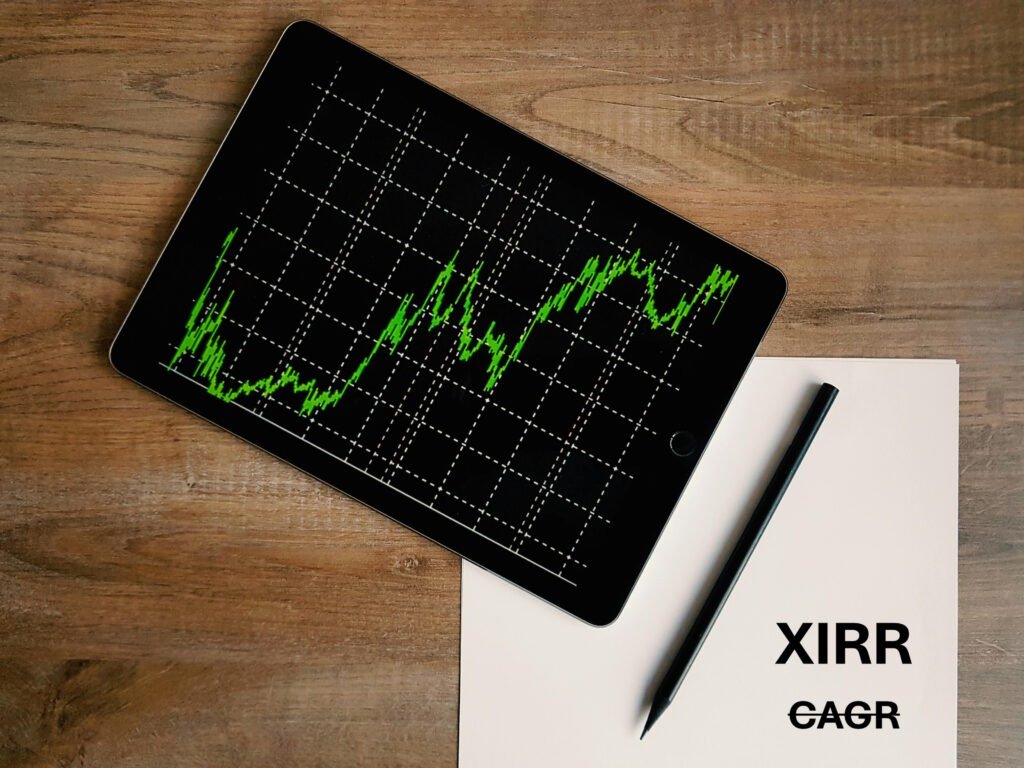A little while back, I wrote about something that many of us nod along to in meetings but rarely fully understand…the absolute growth rate, AAGR and the CAGR. If you missed it, here’s the link:
👉 CAGR, AAGR & The Mystery of Growing Money: A Friendly Guide to Making Sense of Growth Rates.
That post sparked some great conversations. What surprised me most was how many people said: “I finally get CAGR… but wait, what’s this XIRR thing everyone keeps talking about?”
And that, my friend, is exactly where this next conversation begins.
So You’ve Mastered CAGR… But What Happens When Life Gets Messy?
Let’s honest…most people when they look at their investments…they think: “Hmm… I’ve got more money now than when I started. That’s good, right?”
A more informed investor knows that simple before-and-after comparisons barely scratch the surface. That’s when CAGR (compound annual growth rate) helps…at least for a while.
CAGR works great when your investment journey is a straight road.
- You invest ₹10,000 in January 2020.
- Sit tight for 5 years.
- End up with ₹18,000 in January 2025.
CAGR gives you a clean, average rate of return. Simple. Precise. Satisfying.
But real-life investing doesn’t look like that. You invest a little here, withdraw a bit there, maybe top up mid-year. You might:
- Start with ₹50,000
- Add ₹20,000 after a bonus
- Pull out ₹10,000 for an emergency
- Receive a dividend or two
- Finally exit (partially) after a few years
That’s not a straight road—it’s a winding one, with detours and pit stops. That’s where CAGR starts to stumble, and where an incredibly useful metric steps in.
Meet XIRR: The “Grown-Up” Version of CAGR
XIRR, or Extended Internal Rate of Return, is a more nuanced way to calculate the return on your investment when your cash flows don’t follow a predictable schedule.
In simple words: XIRR is what CAGR would be if it paid attention to when you put your money in and when you took it out.
Let’s say:
- You invested ₹50,000 on 15th January, 2021
- ₹15,000 more on 10th March, 2021
- ₹10,000 again on 25th August, 2021
- Then got payouts of ₹10,000, ₹12,000, ₹25,000, and finally ₹60,000 over the next 4 years on 15th February, 2022, 1st July, 2023, 20th January, 2024 and 10th April, 2025 respectively.
CAGR would look at this, shrug and say, “Sorry, I wasn’t built for this.”
But XIRR? It says: “Let me walk through each step with you, date by date.”
That’s what makes it powerful.
How to Use XIRR (Even If You’re Not a Spreadsheet Person)
Good news, XIRR is not some exotic financial tool. It’s right there in Excel or Google Sheets. Here’s how you do it:
- Make two columns: Date and Cash Flow
- Enter every time money went in or came out
- Investments = Negative values (outflows)
- Returns = Positive values (inflows)
- Use this formula:
= XIRR (values, dates)
Voila! Excel will give you the annualized rate of return based on actual cash flow timing.
Want to try it out yourself? Download this practice Excel file. Change the dates and numbers. Try your own scenario. Watch how the rate changes. It’s oddly addictive.
IRR vs XIRR – What’s the Difference?
You might have heard of IRR (Internal Rate of Return) too. While IRR assumes that all your transactions are evenly spaced (like once a year or once a month), XIRR takes actual dates into account. That makes a massive difference in the real world.
- IRR: Works when cash flows are evenly spaced (e.g., yearly)
- XIRR: Works when cash flows happen on any date (which is most of our lives)
Think of IRR as the friend who needs a strict schedule.
XIRR? That’s the cool friend who rolls with your calendar.
Where XIRR Really Comes Alive
Let’s talk real life. Here’s where XIRR shines:
1. Mutual Fund SIPs
You invest every month, markets go up and down, and you redeem different amounts at different times. CAGR can’t keep up, but XIRR tells you the real deal.
2. Real Estate
You buy a flat, spend on interiors, pay maintenance, earn rent, sell it later. The cash flow mess is real, and XIRR handles it like a champ.
3. Angel or Private Investments
You invest in stages. There’s no “one final exit” but rather a few small ones. XIRR tracks it all.
4. Business Owners or Freelancers
You invest when there’s surplus, withdraw when needed. XIRR captures your “financial rhythm”.
What XIRR Can and Can’t Tell You
Here’s the honest truth. XIRR is powerful, but it’s not perfect.
What XIRR can do:
- Tell you the real annual return, accounting for cash flow timing.
- Help compare investments with staggered inflows and outflows.
- Reveal that an impressive CAGR may be hiding a poor real return.
What XIRR can’t do:
- Account for risk or volatility.
- Tell you how stable the investment was.
- Replace common sense and context.
That’s why pros often combine XIRR with things like:
- Standard deviation (How bumpy was the ride?)
- Sharpe ratio (Did I get good returns for the risk I took?)
But for most of us, XIRR is more than enough, and way more insightful than we’re led to believe.
Final Thoughts: Why XIRR Might Be the Most Honest Metric
What I love about XIRR is that it doesn’t oversimplify. It doesn’t assume you did everything “by the book.” Instead, it meets you where you are, with your messy, irregular, wonderfully real cash flows and still gives you clarity.
If CAGR is like checking your weight once a year, XIRR is like tracking your steps, meals, and workouts, it knows what really went into the result.
So go ahead, download the practice Excel file and have a conversation with your money.
It might just surprise you.
And if you haven’t already, do check out the earlier post that kicked this off:
👉 CAGR, AAGR & The Mystery of Growing Money: A Friendly Guide to Making Sense of Growth Rates.

